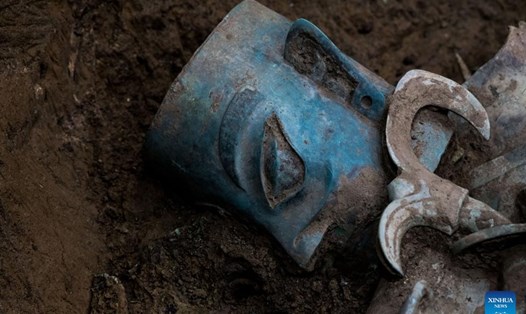Archaeologists who conducted a hunt at the famous Tam Tinh Doi ruins in southwestern China have written about the excavation of more than 10,000 relics from two new pits in recent years - SCMP reported.
The latest findings were found buried under hundreds of elephant ears, according to detailed information published in the journal Sichuan Cultural Relics.
These stunning discoveries range from gold masks, pearls and clam shells to head statues and bronze vases.
One of the excavation sites is the largest of eight burial pits in the so-called "Tam Tinh Doi ceremonial area".
There are up to 7,400 rituals found here, the ruins of a little-known culture that flourished more than 3,000 years ago.
The relic of Tam Tinh Doi or "Three Star Mound" was first discovered in the 1920s. This ancient citadel is said to have been the center of the mysterious settlement 4,500 years ago.
No record has been found to explain the origin of these ancient Thuc people or the meaning of the relics they left behind.
In 1986, Tam Tinh Doi attracted widespread attention after discovering copper, gold and pearl items in previously unknown styles in the pits, showing high economic prosperity and technological skills.
The Tam Tinh Doi relic in Quang Han, Sichuan province, was excavated by researchers from the Sichuan Institute of Cultural Relics and Archaeology and Beijing University from 2020 to 2022.
The second pit on the riverbank has excavated about 2,700 artifacts in 2021.
The discoveries include a "precious cultural relic" made of bronze, including a statue kneeling holding a ceremonial cup on its head, a large mask, an altar, a sacred tree and a square cup with a round mouth.
Among at least four gold masks discovered, one was 20cm wide and attached to a bronze head. About 420 objects crafted from gold leaf were excavated.
Nearly 5,000 bronze artifacts are among the relics recovered from the largest pit, including ceremonial vases, containers, sacred tree branches, head sculptures, masks, human and animal statues, altars and eye-shaped decorations.
In the large hole, archaeologists also found nearly 400 pieces of elephant whale, of which the longest piece was 1.4 meter long. Nearly half of these were longer than 50cm.
Most of the whale nets found were placed intact in the hole - only a few were cut into shorter pieces. Some of the pieces had dark brown burns.
100 pieces of elephant whale in other holes were also found intact, only a few were burned. Scientists point out that burial shows a general model of keeping larger bronze objects and elephant eels above, while smaller artifacts are placed in lower positions.
The ancient community placed pieces of elephant ears on bronze artifacts, with the purpose of completely hiding the bronze objects below. Although they are arranged in no strict order, in general, the elephant nests are arranged in short order so that none of them can emerge.











